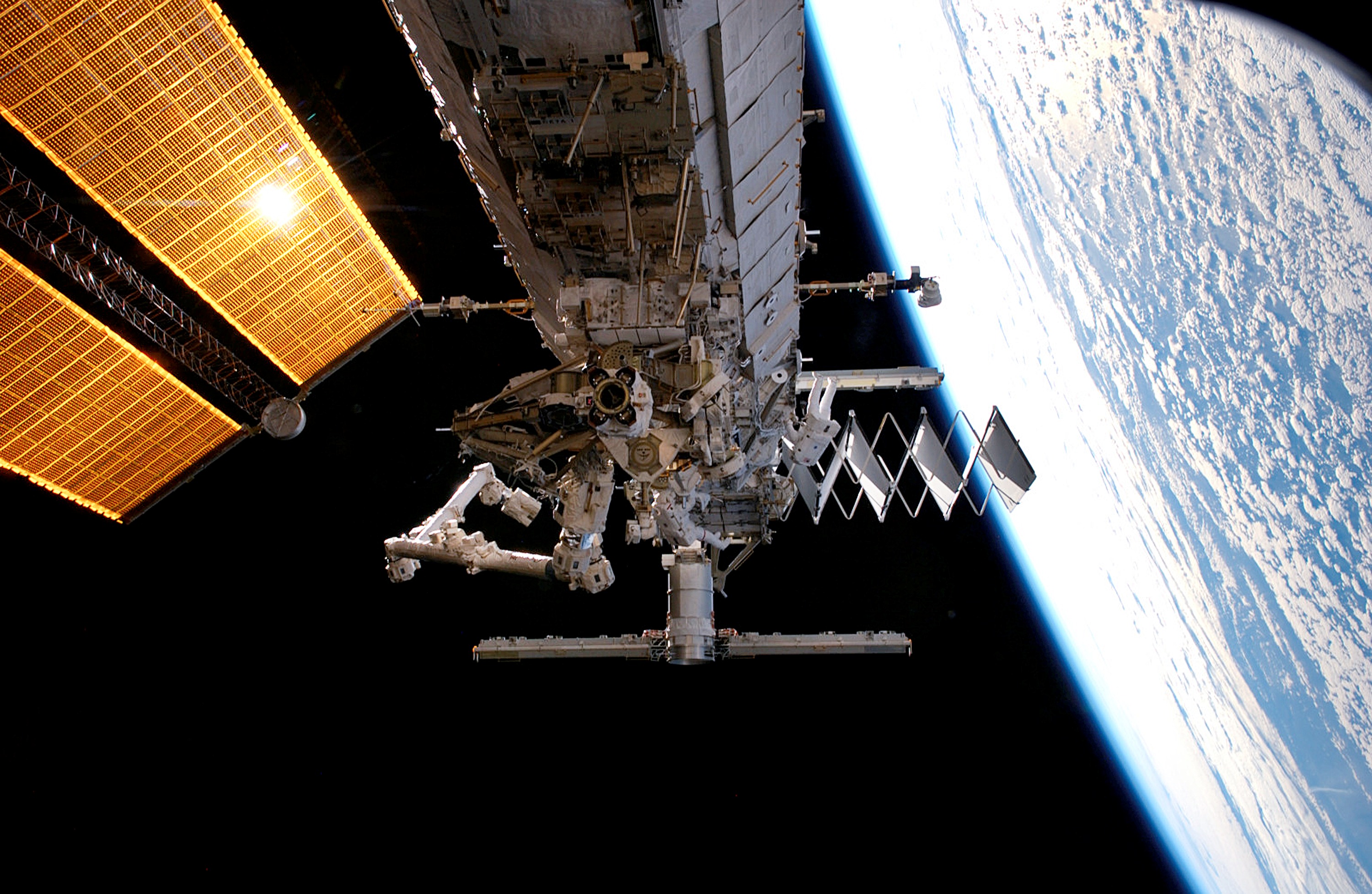
Ten years ago, this week, Space Shuttle Atlantis launched on what would turn out to be the longest mission of her storied career, lasting almost 14 days. Commander Rick “C.J.” Sturckow, Pilot Lee “Bru” Archambault and Mission Specialists Pat Forrester, Steve Swanson, John “Danny” Olivas and Jim “J.R.” Reilly supported four ambitious spacewalks to install and activate the S-3/S-4 truss segment at the International Space Station (ISS). The truss provided a pair of gigantic Solar Array Wings (SAWs), as well as radiators, batteries and associated electronics, to enable the addition of further pressurized modules, including European and Japanese labs. The crew also delivered Clay Anderson to the station for a multi-month tour of duty and returned fellow NASA astronaut Suni Williams to Earth after a record-setting half-year in orbit. Before the flight, Anderson light-heartedly described himself as Williams’ “knight in shining armor”.
Ninety minutes after a smooth docking at the station on 10 June, hatches were opened and the seven-strong STS-117 crew floated into the orbital laboratory, to be greeted with hugs and handshakes from Expedition 15 Commander Fyodor Yurchikhin and Flight Engineers Oleg Kotov and Williams. A safety briefing was followed by the first critical order of business: to formally transfer Williams from being a member of the ISS crew to a member of the STS-117 crew, and vice versa for Anderson.
This was effected by transferring their custom-molded seat liners into and out of the attached Soyuz TMA-10 spacecraft. The latter would be used by the station crew in the event of an emergency return to Earth. By 8:55 p.m. EDT, Anderson’s seat was in place aboard the Soyuz, thereby completing the crew transfer.
Next was the unberthing of the 45-foot-long (13.7-meter) S-3/S-4 segment, which would form the next component of the station’s Integrated Truss Structure (ITS), holding batteries, radiators and a third pair of electricity-generating Solar Array Wings (SAWs). At the controls of Atlantis’ Remote Manipulator System (RMS) arm, Archambault and Forrester grappled the payload—which, at 35,600 pounds (16,150 kg), represented one of the largest and heaviest ISS components ever taken into orbit—and positioned it for a robotic “handover” to the station’s Canadarm2 mechanical arm, operated by Williams.
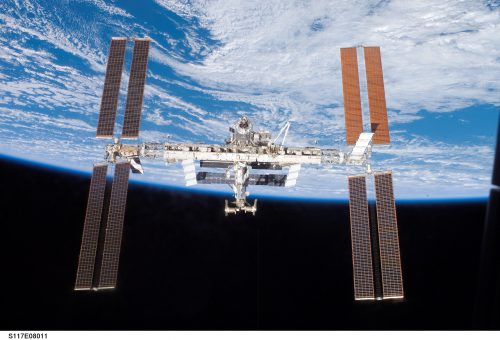
By 8:28 p.m. EDT on 10 June, the new truss segment was formally in the “hands” of the space station, but it would not be physically installed until the following afternoon. This enabled Archambault, Forrester and Kotov to position it about 5 feet (1.5 meters) from the starboard edge of the S-1 truss, allowing four bolts to be autonomously driven for its permanent installation. “I’ll go ahead and manually fly this into an install, basically to install it until we get ready-to-latch indications,” Archambault explained, before the flight. “What we’ll do there in between that meter-and-a-half…is we’re going to pause for about a few moments at around 18 inches (45 cm) to allow our Space Vision System to go ahead and give me an updated depiction of my exact position with respect to the S-1 truss, and be able to install this thing within a 0.4-0.8-inch (1-2 cm) tolerance.”
The first EVA of the mission got underway at 4:02 p.m. on 11 June. Like the previous spacewalks conducted during STS-115 in September 2006, Reilly and Olivas followed a “campout pre-breathe” protocol, spending the night inside the Quest airlock under reduced atmospheric pressures of 10.2 psi to facilitate the purging of nitrogen from their bloodstreams. The astronauts were about an hour behind schedule when they emerged from the Quest airlock, due to a temporary attitude-control loss across the station. One of the four Control Moment Gyroscopes (CMGs)—located in the Z-1 truss—had gone offline, partly in response to the mass of the S-3/S-4 segment and the “skewed symmetry” which it emplaced on the ISS configuration.
Veteran spacewalker Reilly and first-timer Olivas stepped smartly through their tasks on the six-hour and 15-minute EVA, connecting power, data and cooling cables between S-1 and S-3/S-4, removing launch restraints from the four Solar Array Blanket Boxes (SABBs) on the new truss—thereby readying the arrays for deployment the following day—and releasing wire-braided cinches and winch bars holding the S-4 Photovoltaic Radiator (PVR) in place. Additionally, Reilly and Olivas rotated the keel pin on S-3, rigidized four Alpha Joint Interface Structure (AJIS) struts and installed the first pair of a total of four Drive Lock Assemblies (DLA-2) onto the Solar Alpha Rotary Joint (SARJ).
The work involved a significant use of the hand-held Pistol Grip Tool (PGT) to remove bolts. Before the mission, Steve Swanson quipped that there were so many bolts involved that the spacewalkers expected to run down the batteries of their PGTs very rapidly.
Overnight, flight controllers at the Mission Control Center (MCC) at the Johnson Space Center (JSC) in Houston, Texas, commanded the initial deployment of both solar array wings. Their full deployment to a length of 115 feet (35 meters)—extending almost 240 feet (73 meters) from tip to tip—was done under the close supervision of the crew, with the panels being opened sequentially to let them soak up the Sun and avoid the “stiction” issues which had occurred on previous missions.
“We’ll deploy them to 49 percent and then we’ll let them have solar insulation and then we will go ahead and deploy ’em to the full extension, 31.5 bays,” said Sturckow, before the mission. “This process of baking them out, during solar insulation on the back side of the panels, allows that stiction to be removed, so that they can smoothly deploy to a full 100 percent.” The first SAW was unfurled at 12:29 p.m. and the second at 1:58 p.m.
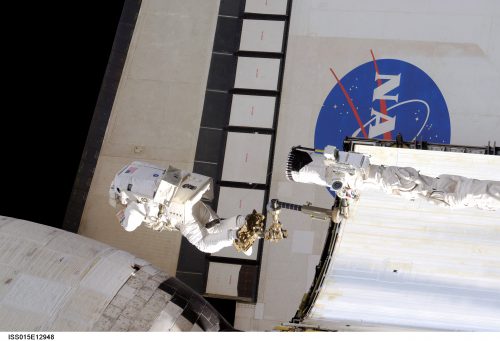
This neatly set the scene for EVA-2 on 13 June, executed by veteran spacewalker Forrester and first-timer Swanson. They spent seven hours and 16 minutes outside, removing the launch locks for the 10-foot-diameter (3.3-meter) SARJ, which would allow the arrays to rotate and continuously track the Sun. However, they ran into difficulties when Forrester came to install the second pair of Drive Lock Assemblies (DLA-1). He found that commands being sent to it were actually being received by DLA-2—installed a couple of days earlier by Reilly and Olivas—and Mission Control set to work investigating the problem. The DLAs served a crucial role of engaging gears which allowed the SARJ to rotate. It was later confirmed that the DLA-2 from Reilly and Olivas’ spacewalk was in a safe configuration, as was DLA-1.
However, the configuration of the station at that time also required the crew to retract the starboard-side solar array (known as “Channel 2B”) of the P-6 truss. Installed by the STS-97 shuttle crew in late 2000, P-6 provided an early electrical power capability for the station and was initially situated atop the Z-1 truss. In order for the SARJ on the S-3/S-4 segment to fully rotate the new arrays, it was necessary for P-6’s arrays to be fully retracted. The port-side (“Channel 4B”) array of P-6 had been folded up during STS-116 in December 2006 and with its starboard-side counterpart smoothly folded away, it placed the ISS in pole position for P-6 to be relocated, later in 2007, to its final location at the far-port edge of the ITS.
Unfortunately, the retraction of Channel 2B proved a little more troublesome than anticipated. Before EVA-2, ground controllers were able to remotely command 7.5 of the 31.5 solar array “bays” to fold up into their SABB and Forrester and Swanson were able to assist by poking and prodding a further 5.5 bays to close. The spacewalkers then pressed on with their other tasks: deploying SARJ “brace beams” on the S-3/S-4 truss and removing launch locks, but left the removal of associated launch restraints until EVA-3.
Dovetailed into these plans was the need to tend to an issue with Atlantis herself. As outlined in yesterday’s AmericaSpace article, a small section of thermal blanket close to the shuttle’s Orbital Maneuvering System (OMS) pod—measuring 4 inches (10 cm) by 6 inches (15 cm)—had become detached and raised from adjoining protective tiles. The Mission Management Team (MMT) had already elected to extend STS-117 by 48 hours in order to accommodate an additional spacewalk to resolve the issue.
And resolution of that issue was Reilly and Olivas’ task on EVA-3. The pair headed out of the Quest airlock at 1:25 p.m. EDT on 15 June, a few minutes earlier than timelined. With Olivas riding a portable foot restraint at the end of the shuttle’s RMS arm, and Reilly free-floating, they set to work. For two hours, Olivas labored to staple and pin the blanket, whilst Reilly installed the hydrogen vent valve for a new oxygen generation system onto the Destiny lab. With both tasks completed, they assisted in folding the remaining 15 bays of Channel 2B into the P-6 SABB. Retraction of the array and closure of its box were confirmed at 8:40 p.m. All told, 45 commands were needed to complete the task. By the time Reilly and Olivas returned inside Quest, EVA-3 had run for seven hours and 58 minutes, the second-longest spacewalk dedicated to ISS construction and maintenance at that time.
Against the backdrop of these EVAs, the Russian Orbital Segment (ROS) was battling a series of problems of its own, centered upon its navigation computers. Late on 12 June, flight controllers attempted to transfer attitude control from Atlantis over to station computers in readiness for EVA-2, but this prompted a forced reboot of the main Russian command and control computer. (During efforts to troubleshoot the problem, the crews received a rude early-morning wakeup call, when a false fire alarm sounded in the Zarya control module.) Together with Yurchikhin and Kotov, flight controllers worked for several days, eventually restoring four of the six computer channels after bypassing a faulty power switch. By 16 June, the remaining pair of channels were back online and a satisfactory test of attitude control handover from the shuttle to Russian station computers, and from thence to U.S. computers and the CMGs, was effected early on the 18th.
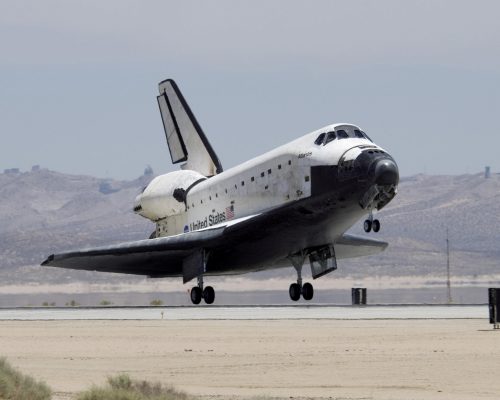
As well as turning out to be Atlantis’ longest mission, STS-117 saw Suni Williams establish a new record for the longest single spaceflight by a woman. At 1:47 a.m. EDT on 16 June, she eclipsed fellow NASA astronaut Shannon Lucid’s achievement of 188 days and four hours, set at the close of her six-month voyage to the Mir space station a decade earlier. “I was just in the right place at the right time,” Williams remarked. “It’s an honor to be here.” She certainly remain in the “right place” later in her career, too. Although she eventually lost the record for the longest single spaceflight by a woman to Italian astronaut Samantha Cristoforetti in June 2015, Williams still stands as one of the most experienced female astronauts of all time.
Wrapping up an impressive quartet of EVAs on 17 June, Forrester and Swanson spent six hours and 29 minutes attaching a television camera on to the S-4 truss and verifying the configuration of DLA-2. They removed the last six SARJ launch restraints and by the midpoint of the spacewalk they had cleared a “pathway” on S-3 for the station’s Mobile Base System (MBS), by removing temporary rail-stops and other hardware.
After more than a week together, the STS-117 and Expedition 15 crews bade each other farewell and hatches were closed the following evening. At 10:42 a.m. EDT on 19 June, Atlantis undocked from the station and Archambault took manual control, separating to a distance of 450 feet (140 meters) and performing the customary flyaround inspection. During the course of the flyaround, the crew extensively photographed the ISS, which now presented a symmetrical appearance, with sets of solar array wings on both the port side of the ITS and on the starboard side.
Touchdown at the Kennedy Space Center (KSC) in Florida was targeted for 21 June, with two opportunities to alight on the Shuttle Landing Facility (SLF). In readiness for these attempts, Sturckow, Archambault and Swanson conducted the day-before-landing checks of Atlantis’ hydraulics and flight control surface and tested her maneuvering thrusters. According to STS-117 Entry Flight Director Norm Knight, KSC was to be the only landing site under consideration—with the backup location at Edwards Air Force Base, Calif., not expected to be required—based on the wealth of consumables aboard the shuttle. It was noted that Atlantis could remain comfortably on-orbit until 24 June.
However, with a chance of rain showers approaching within 30 miles (50 km) of the KSC runway and a cloud deck a 5,000 feet (1,500 meters), a pair of violating factors stood in the mission’s way right from the outset. As a consequence, there was little option but to wave off the landing and aim instead for a touchdown the following day. At 4:59 p.m. EDT on 21 June, the STS-117 astronauts eclipsed STS-98’s 12 days and 21 hours as the longest flight ever undertaken by Atlantis.
But with thunder showers expected to continue in Florida, it seemed that Edwards was the best option for Sturckow’s crew. Perhaps in recognition of his role, Marine Corps Col. Sturckow was awakened to the sound of the Marine Corps Hymn on the morning of 22 June. Committed to a California homecoming, Atlantis’ Orbital Maneuvering System (OMS) engines were fired on time and the shuttle began a sweeping hypersonic descent back through Earth’s “sensible” atmosphere. At 300 feet (100 meters) above concrete Runway 22, Archambault lowered the landing gear, allowing Sturckow to execute a textbook landing at 12:49:38 p.m. PDT (3:49:38 p.m. EDT).
All told, STS-117 had run for 13 days, 20 hours, 12 minutes and 44 seconds, covering 5.8 million miles (9.3 million km).
This is part of a series of history articles, which will appear each weekend, barring any major news stories. Next week’s article will focus on the 40th anniversary of the first flights of Enterprise, which performed Approach and Landing Tests (ALT) of the shuttle in the summer of 1977.
Be sure to “LIKE” AmericaSpace on Facebook and follow us on Instagram & Twitter!





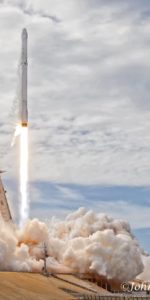
wonderful post, very informative. I ponder why the other experts of this sector do not realize this. You should continue your writing. I am sure, you have a huge readers’ base already!